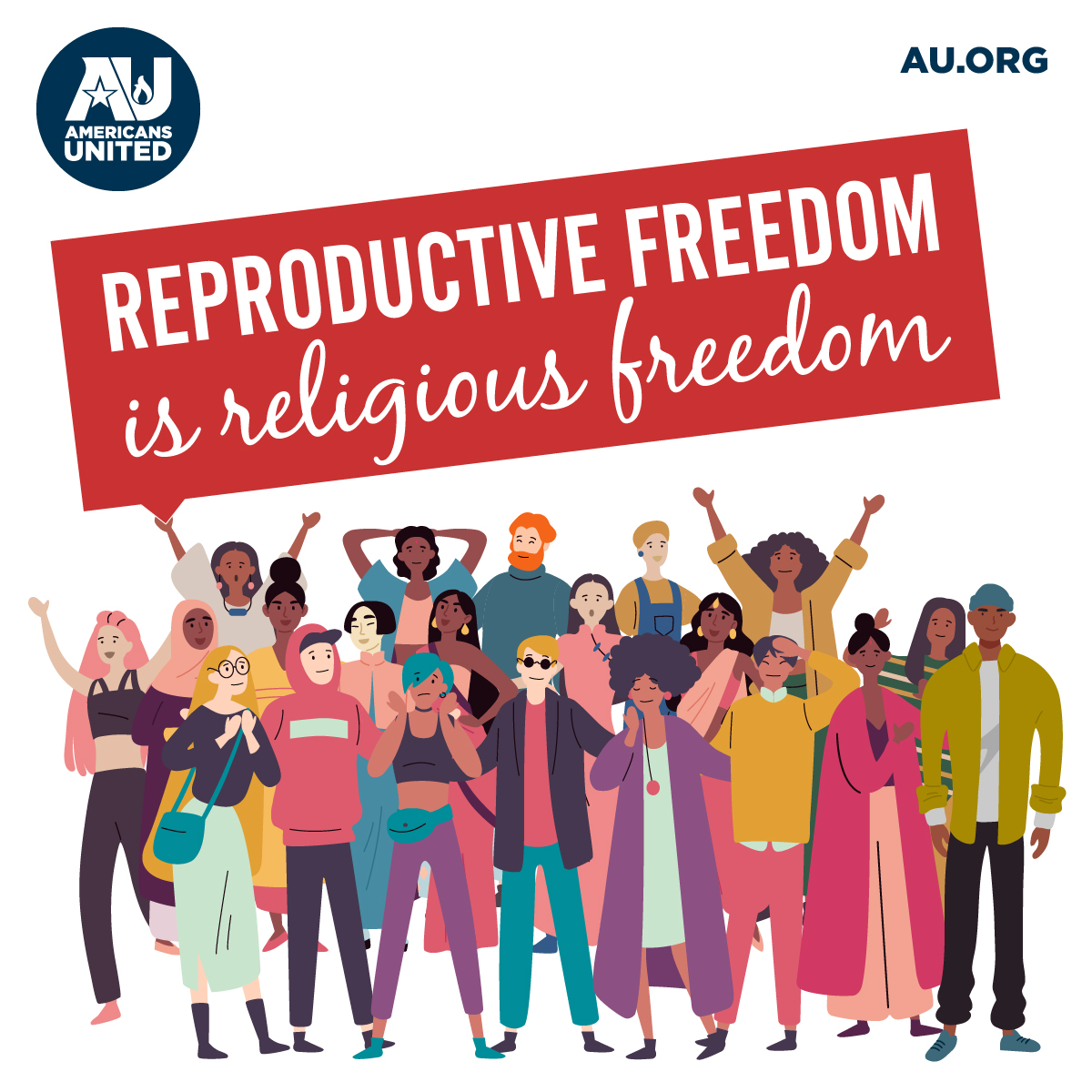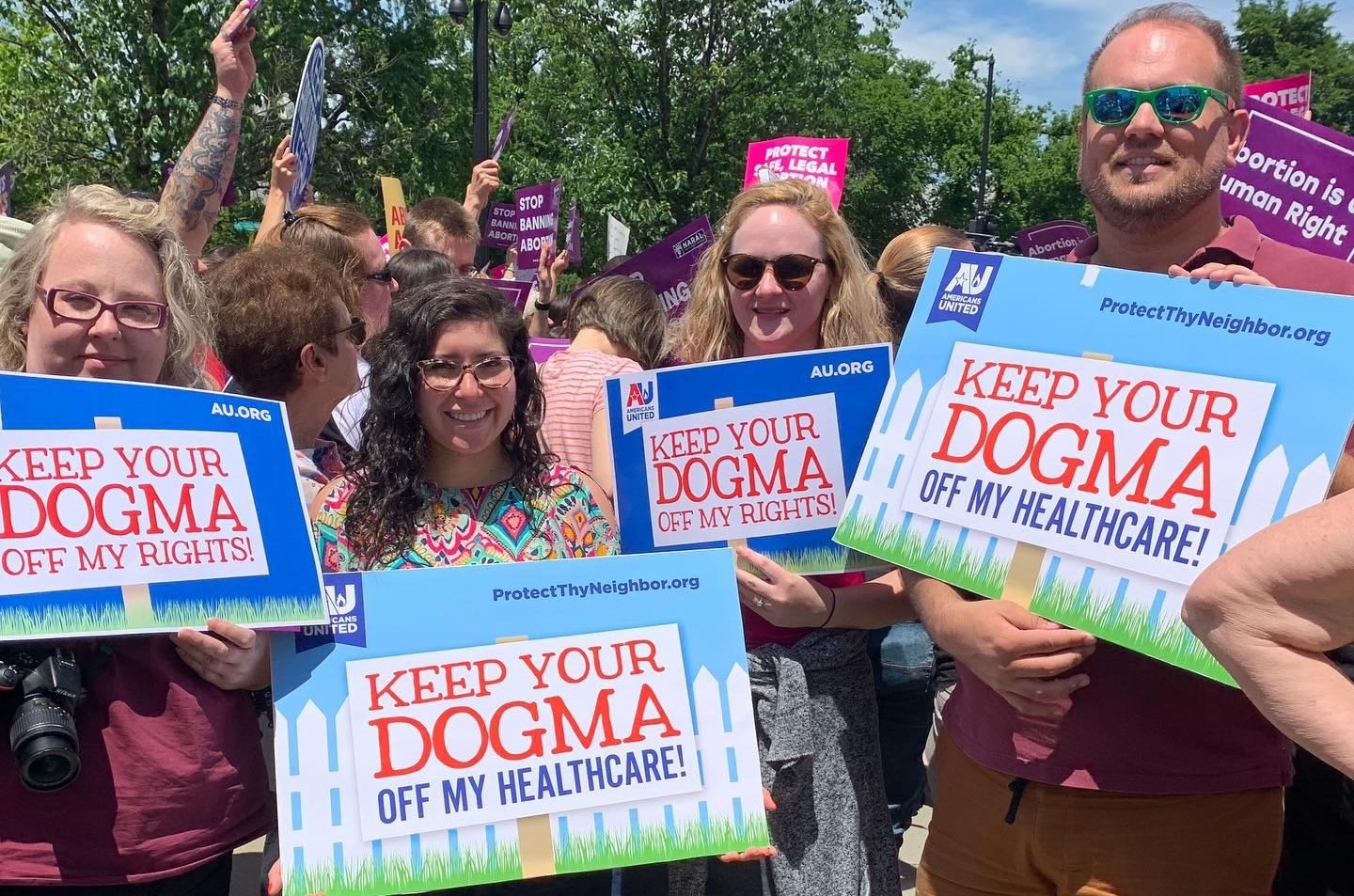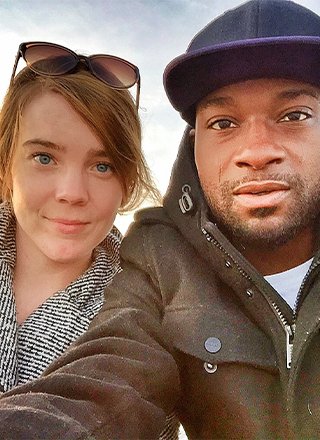On Jan. 22, 1973, the U.S. Supreme Court issued its landmark Roe v. Wade decision upholding abortion as a constitutional right and invalidating laws in several states that banned it.
In an article in Church & State the following March, Americans United called the decision a “middle way” and endorsed language from a New York Times editorial that asserted that the decision “provides a sound foundation for final and reasonable resolution of a debate that has divided America too long.”
|
In hindsight, it’s easy to see that The Times’s editorial and AU’s optimism were misplaced. Far from providing a definitive solution to the issue of abortion, Roe ushered in a reproductive-rights-based culture war that has been raging for the past 46 years. While issues of women’s rights, health care and reproductive freedom have dominated the debate, the issue of separation of church and state has percolated just beneath the surface all along. That’s because opposition to Roe tends to be grounded in religion. As Americans United noted in its 1973 report about Roe, the decision was immediately attacked by the hierarchy of the Roman Catholic Church. Church leaders relied on thinly veiled – or sometimes blatant – religious arguments in opposing legal abortion. That’s been their mainstay ever since. By contrast, most Protestant groups were initially supportive of Roe – even the Southern Baptist Convention (SBC) and evangelical denominations. W.A. Criswell, a former SBC president who was at the time the pastor of a prominent Southern Baptist church in Dallas, issued a statement supporting the high court’s decision. Prominent Jewish groups did the same. |
 |
But it didn’t take long for the religious dynamic over abortion to begin shifting dramatically. By the late 1970s, the Catholic hierarchy had new religious allies in its quest to roll back Roe as the nation saw the rise of the Religious Right, a movement composed primarily of fundamentalist Protestants. Within a few years, a resurgent fundamentalist movement had seized control of the SBC and flipped its position on abortion. At the same time, far-right religious factions grew in power in other Protestant denominations and pressured their leaders to step away from a pro-choice view.
Motivated chiefly by religious zeal, far-right activists and their political allies in Congress and state legislatures immediately began working to undermine Roe. Just three years after the decision, Congress struck the first blow, passing a law banning the use of Medicaid funds to pay for abortions for poor women. As former New York Times Supreme Court reporter Linda Greenhouse noted in a May 23 column, the debate over the Hyde Amendment was laced with religious references, and a lobbyist for the Catholic Church advised anti-abortion legislators.
Various anti-abortion measures have passed since then, both in Congress and in the states. Some have been struck down and others upheld. But a spate of new laws that have just been approved in some states are notable for their brazenness. They’re considered a direct challenge to Roe and an invitation for the high court to reconsider and overturn that ruling – a long-sought goal of the Catholic hierarchy and the Religious Right.
Prognosticators have predicted the demise of Roe before, but this time it just might happen. Thanks to the two appointments by President Donald Trump – Justices Neil Gorsuch and Brett Kavanaugh – the Supreme Court is firmly in the conservative camp. Many legal observers believe Roe is hanging by a thread, and some states are eager to hasten its demise by placing a new test case before the justices.
The latest drive to overturn Roe is motivated in a large part by the ultra-conservative religious beliefs held by many lawmakers.

(PHOTO: Americans United staff rally for abortion rights outside the Supreme Court in May.)
In Alabama, where a new law bans most abortions and provides no exceptions for victims of rape or incest, state Sen. Clyde Chambliss (R-Dist. 30) argued in favor of the measure by saying, “I believe that if we terminate the life of an unborn child, we are putting ourselves in God’s place.” When Alabama Gov. Kay Ivey (R) signed the bill into law, she also cited religious rationale, remarking, “This legislation stands as a powerful testament to Alabamians’ deeply held belief that every life is precious and that every life is a sacred gift from God.”
In Missouri, where a similar law has passed, state Rep. Holly Rehder (R-Dist. 148) explained her support for an abortion ban that does not contain rape or incest exemptions by saying, “How can someone look at a child of rape or incest and care for them? I can say, how we can do that? We can do that with the love of God.”
The terrifying rash of abortion bans spreading throughout our country has captured the nation’s attention, but in order to stop this trend, those who are fighting back must also focus on its deeper cause: the ever-crumbling wall of separation between church and state. The First Amendment of our Constitution prohibits the government from imposing one set of religious beliefs, or religion at all, on others, but that’s undeniably what these bans are doing.
~ Rachel Laser, AU President and CEO
Missouri has a long history of working religious rhetoric into its anti-abortion laws. In the late 1980s, the state passed an anti-abortion bill that, among other things, declared that life begins at conception. A legal challenge to the law sponsored by Planned Parenthood reached the Supreme Court in 1989, where Americans United filed a legal brief arguing that the origin of life is a theological, not scientific or legal, construct. As such, AU argued, it had no place in the preamble of the Missouri law.
Although Justice John Paul Stevens accepted AU’s argument, the other justices were not swayed. The law, including its controversial preamble, was upheld in the case Webster v. Reproductive Health Services.
At the time AU filed the brief, the organization was no stranger to the issue of reproductive choice. Access to birth control had long been of interest to Americans United. Not long after AU was founded in 1947, the organization began advocating for the right of couples to access birth control and information about it. The group opposed state laws that restricted contraceptive access and gagged doctors from talking about birth control with their patients.
Throughout the 1950s and ’60s, Americans United worked to strike down state laws that outlawed the use of birth control and made it illegal for doctors even to counsel couples about it. Such laws, once common in some states, were put in place after lobbying campaigns led by the Catholic hierarchy. (It’s important to note that these days, most lay Catholics disagree with the hierarchy on these issues. Catholics for Choice has noted that 72 percent of church members believe one can disagree with church teachings on birth control yet remain a faithful member, and research by the Guttmacher Institute shows that Catholic women undergo abortions at the same rate as non-Catholic women.)
In the mid-1960s, stories about abortion first began appearing in Church & State. AU noted the heavy-handed clerical presence behind many of the anti-abortion laws.
In September 1976, the magazine published “No Retreat on Abortion” by John D. Rockefeller III. Reprinted from Newsweek, the piece linked the issue to religious freedom.
“The most powerful arguments about abortion are in the field of religious and moral principles – and this is where the opposing views clash head-on,” Rockefeller, then chair of the Population Council, wrote. “Abortion is against the moral principles defended by the Roman Catholic Church, and some non-Catholics share this viewpoint. But abortion is not against the principles of most other religious groups.”
Continued Rockefeller, “Those opposed to abortion seek to ban it for everyone in society. Their position is thus coercive in that it would restrict the religious freedom of others and their right to make a free moral choice. In contrast, the legalized abortion viewpoint is non-coercive. No one would think of forcing anyone to undergo an abortion or forcing doctors to perform the procedure when it violates their consciences. Where abortion is legal, everyone is free to live by her or his religious and moral principles.”
Similar arguments resurfaced in January 1990 when Church & State ran an opinion column by Paul D. Simmons, at the time a professor of Christian ethics at the Southern Baptist Theological Seminary in Louisville, Ky. Simmons made the case that the abortion issue has important church-state overtones. (The article was adapted from a speech Simmons, who later joined AU’s board, had delivered at a national conference AU had held the previous fall.)
“One of the great values of the Roe decision is that no woman was coerced to act in ways contrary to her religious scruples and moral value system,” Simmons observed. “For those who believe strongly that zygotes are persons, there is no coercion to terminate a pregnancy, even under the most problematic circumstances. On the other hand, those women whose religious and moral belief systems permit abortion under certain circumstances were respected and protected. It belongs to the woman to decide based upon her religious beliefs.”
Added Simmons, “Religious groups are also free to teach their followers whatever doctrinal formulations of personhood they believe consistent with their commitments to tradition and theology. Without ever saying so, Roe v. Wade was an exercise in protecting religious liberty.”
For those who believe strongly that zygotes are persons, there is no coercion to terminate a pregnancy, even under the most problematic circumstances. On the other hand, those women whose religious and moral belief systems permit abortion under certain circumstances were respected and protected. … Without ever saying so, Roe v. Wade was an exercise in protecting religious liberty.
~ Paul D. Simmons, Southern Baptist Theological Seminary professor in 1990
Simmons’s middle way has been soundly rejected by the Catholic bishops, the Religious Right and their political allies. As a result, the new flock of anti-abortion laws reflect extreme positions. A law passed in Georgia, for example, defines fetuses as legal persons. While the law does not directly specify penalties for women who get an abortion or doctors who provide them, under the state’s existing criminal statutes both parties could be charged with homicide. Some legal experts say the law is so broadly written it could apply to a woman who undergoes abortion in a state where it’s legal once she returns to Georgia. (Georgia’s bill is a type of backdoor abortion ban known as a “heartbeat bill.” It would ban abortion once a fetal heartbeat is detected, usually around six to eight weeks – even though many women don’t even know they’re pregnant at this stage. Similar measures have been passed in Mississippi, Ohio, Missouri, Louisiana and Kentucky.)
In Texas, some lawmakers have proposed legislation that would make it possible to charge a woman who gets an abortion with homicide, meaning she could, if found guilty, be sentenced to death.
The Alabama law focuses on providers. It doesn’t penalize women who seek an abortion but says doctors who perform the procedure could be sentenced to up to 99 years in prison.
For years, the most extreme elements of the Religious Right have argued for harsh penalties for both women who get abortions and the doctors who provide them. Christian Reconstructionists, a fringe Religious Right movement that espouses a theocracy based on the legalistic books of the Hebrew Bible, equate all abortions with murder and advocate the death penalty for women and doctors.
More mainstream Religious Right groups usually try to avoid talking about the issue of imprisoning women who seek abortions because they know most Americans find that repellent. But on at least one occasion, their political champion, President Donald Trump, let the truth slip out. During a March 2016 forum in Green Bay, Wisc., Trump, who once supported abortion rights but now insists that he is “pro-life,” backed “some form of punishment” for women seeking abortions. Pressed on the matter by MSNBC host Chris Matthews, all Trump would say is that the type of punishment “will have to be determined.”
Americans United is watching developments closely. The organization is stepping up to explain the ties between reproductive freedom and church-state separation.
AU is not alone here. As extreme anti-abortion laws take hold in more and more states, some legal observers aren’t hesitating to label them violations of church-state separation.
In her recent New York Times column, Greenhouse called for a theory of abortion rights firmly anchored in the Establishment Clause – that portion of the First Amendment that bars government from making laws “respecting an establishment of religion.”
[I]t’s past time for the rest of us to step back and consider the impact of religion’s current grip on public policy – not only on the right to abortion, but on the availability of insurance coverage for contraception in employer-sponsored health plans and on the right of gay and transgender individuals to obtain medical services without encountering discrimination.
~ Linda Greenhouse, New York Times columnist
“If the First Amendment’s Establishment Clause means anything, it has to mean that God’s will cannot be a constitutional justification for a law that erases an individual right,” observed Greenhouse.
She went on to say, “I’m realistic about this. I’m not expecting judges to embrace the Establishment Clause as the basis for invalidating the Alabama Human Life Protection Act, and I’m not expecting even progressive politicians to call out the religious basis for the wave of anti-abortion laws, of which Alabama’s is the most extreme. But it’s past time for the rest of us to step back and consider the impact of religion’s current grip on public policy – not only on the right to abortion, but on the availability of insurance coverage for contraception in employer-sponsored health plans and on the right of gay and transgender individuals to obtain medical services without encountering discrimination.”
In a May 27 op-ed column for the Chicago Tribune, Americans United President and CEO Rachel Laser made a similar argument, pointing out that the spate of efforts to curtail abortion access could be stopped by a high and firm church-state wall.
“The terrifying rash of abortion bans spreading throughout our country has captured the nation’s attention, but in order to stop this trend, those who are fighting back must also focus on its deeper cause: the ever-crumbling wall of separation between church and state,” Laser wrote. “The First Amendment of our Constitution prohibits the government from imposing one set of religious beliefs, or religion at all, on others, but that’s undeniably what these bans are doing.”


